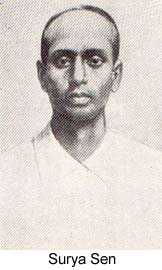

 |  |
 Surya Sen had actively participated in the non-cooperation movement and was popularly known as Masterda. Arrested and imprisoned for two years, from 1926 to 1928, for revolutionary activities, he continued to work in the Congress. In 1929, Surya Sen was a Secretary and five of his associates were members of the Chittagong District Congress Committee.
Surya Sen, a brilliant and inspiring organizer, was an unpretentious, soft spoken and transparently sincere person. He was fond of saying: 'Humanism is a special virtue of a revolutionary'. He was a great admirer of Rabindra Nath Tagore, and Kazi Nazrul Islam.
Surya Sen had actively participated in the non-cooperation movement and was popularly known as Masterda. Arrested and imprisoned for two years, from 1926 to 1928, for revolutionary activities, he continued to work in the Congress. In 1929, Surya Sen was a Secretary and five of his associates were members of the Chittagong District Congress Committee.
Surya Sen, a brilliant and inspiring organizer, was an unpretentious, soft spoken and transparently sincere person. He was fond of saying: 'Humanism is a special virtue of a revolutionary'. He was a great admirer of Rabindra Nath Tagore, and Kazi Nazrul Islam.Surya Sen soon gathered around himself a large band of revolutionary youth including Anant Singh, Ganesh Ghosh and Lokenath Baul. They decided to organize a rebellion, on however small scale, to demonstrate that it was possible to challenge the armed might of the British in India. Their action plan was to include occupation of the two main armories in Chittagong and seizing of their arms with which a large band of revolutionaries could be formed into an armed detachment; the destruction of the telephone and telegraph system of the city; and the dislocation of the railway communication system between Chittagong and the rest of Bengal. The action was carefully planned and put into execution at 10 o'clock on the night of 18 April 1930. A group of six revolutionaries led by Ganesh Ghosh, captured the Police Armoury, shouting slogans such as Inquilab Zindabad, Down with Imperialism and Gandhi's Raj has been estabtished. Another group of ten, led by Lokenath Baul, took over the Auxiliary Force Armoury along with its Lewis guns and 303 army rifles. Unfortunately they could not locate the ammunition. This was to prove a disastrous setback to the revolutionaries plans. The revolutionaries also succeeded in dislocating telephone and telegraph communications and disrupting movement by train. In all, sixty five were involved in the raid, which was undertaken in the name of the 'Indian Republican Army', Chittagong Branch. All the revolutionary groups gathered outside the Police Armoury where Surya Sen, dressed in immaculate white khadi dhoti and a long coat and stiffly ironed Gandhi cap, took a military salute, hoisted the National Flag among shouts of Bande Mataram and Inquilab Zindabad and proclaimed a Provisional Revolutionary Government. It was not possible for the band of revolutionaries to put up a fight in the town against the army which was expected. They, therefore, left Chittagong town before dawn and marched towards the Chittagong hill ranges, looking for a safe place. It was on the Jalalabad Hill that a thousand troops surrounded them on the afternoon of 22 April. After a fierce fight, in which over eighty British troops and twelve revolutionaries died, Surya Sen decided to disperse to the neighbouring village there they formed into small groups and conducted raids on Government personnel and property. Despite several repressive measures and operations by the authorities, the villagers, gave them food and shelter to the revolutionary outlaws and enabled them to survive for three years. Surya Sen was fmally arrested on 16 February 1933, tried and hanged on 12th January 1934. A remarkable aspect of this new phase of the terrorist movement in Bengal was the large scale participation of young women under Surya Sen's leadership, they provided shelters, acted as messangers and custodians of arms and fought guns in hand. Preetilata Waddekar died while conducting a raid, while Kalpana Dutt (now Joshi) was arrested and tried along with Surya Sen and given a life sentence. In December 1931, two school girls Commilla, Shanti Ghosh and Suneeti Chaudhary, shot dead the district magistrates. In December 1932, Beena Das fired point blank at the Governor while receiving her degree at the convocation. The end of this section |
Copyright ©2000 indiansaga.info. All rights reserved.
By using this service, you accept that you won't copy or use the data given in this website for any commercial purpose.
The material on indiansaga.info is for informational & educational purpose only.
This site is best viewed at 800 X 600 picture resolution.